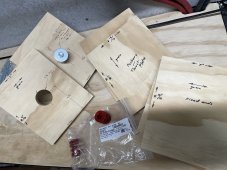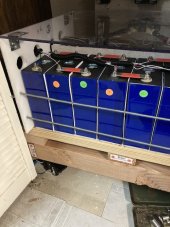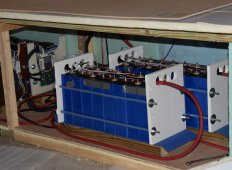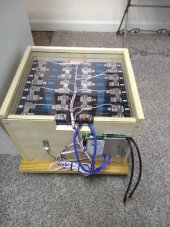Edit: for un swollen cells!
I use two boxes with 8 cell each.
A centralized spring is used to compress at 550 lbs for 10 psi and WHEN they expand they expand approximately .025” per cell they should still be under 12 psi across the wide surface. The ends and pusher are doubled/glued for a 1-1/2” thickness needed to not bend over time. The adjustment end plate has a hole in one doubler to clear the washer to facilitate loading the spring while shortening the overall length. This is the dimensions and list of what’s in use but my next one (not finalized) will be longer and higher for a compartment for the bms and a cover the only thing thing that stays the same is the pusher. Material List for:
Eight Cell Compression Module
(lithium "Squeeze Box")
Fits most 272/320 Ah Prismatic LiFePO4 cells with allowance for spacer/insulators
sheets on wide battery surfaces (9 places).
Home Depot 2' X 4' plywood Sheets, Radiata Pine 1/2"(.480) & 3/4"(.725) thick:
1pc Bottom 3/4" X 7" X 29-1/8"*
2pcs Sides 1/2" X 9" X 29-1/8"*
4pcs Ends 3/4" X 7"* X 8-5/16" (2per end)
2pcs Thrust plate 3/4"X 6-15/16" X 8-1/8"*
*Denotes surface grain direction. Doubled thrust plate has the only vertical grain.
Ends sit on bottom and between sides. 1pc Spring, 634.6 LB @ .56" deflection
from MSC (mscdirect.com) PN 07661879.
1pc 3/8-16 four pronged Flange nut
1pc 3/8-16 X 3" Bolt, zinc plate (not stainless! it may bend)
1pc 3/8 fender washer, 2pcs 3/8-16 nuts
Grease for threads and washer surface.
Teks sharp point lath screws #8x1-1/4" to align while gluing.
Clamp up assembly squarely before gluing. Drill tight clearance holes through first side
and pre-drill small hole for threads.
Titebond 3 glue, re-coat edges after a few minutes soak in before assembly.
When done, protect with Minwax Helmsman Urethane 3 coats or you may wish to treat with fire retardant.
Sand between coats, warning very DUSTY!
One roll of Formica from Home Depot for cell spacers or purchase “epoxy insulator sheets” from 18650batterystore.com
If you treat the wood with fire retardant, do so after gluing because it may interfere with bond.
















